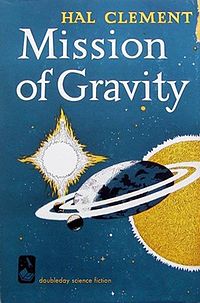- Mission of Gravity
-
Mission of Gravity 
Cover of first edition (hardcover)Author(s) Hal Clement Country United States Language English Genre(s) Science fiction novel Publisher Doubleday Publication date April–July 1953 (in serial) & 1954 (in book form) Media type Print (Magazine, Paperback & Hardback) ISBN NA Followed by Star Light Mission of Gravity is a science fiction novel by Hal Clement. The novel was serialized in Astounding Science Fiction magazine in April–July 1953. Its first hardcover book publication was in 1954, and it was first published as a paperback book in 1958. Along with the novel itself, many editions (and most recent editions) of the book also include "Whirligig World", an essay by Clement on creating the planet Mesklin that was first published in the June 1953 Astounding.
Clement published two sequels to Mission of Gravity, a 1970 novel called Star Light, and a 1973 short story called "Lecture Demonstration". Mission of Gravity was nominated for a "Retro Hugo" Award for the year 1954.
Contents
Setting
The story is set on a highly oblate planet named Mesklin, which has surface gravity that varies between 700 g at the poles and 3 g at the equator. The story is told from the points of view of one of the local intelligent life forms and a human explorer. The locals are centipede-like, in order to withstand the enormous gravity, and terrified of even small heights (because in 700 g even a tiny fall is fatal). (See Mesklin for a more comprehensive description of the planet's characteristics.)
Plot summary
The native protagonist, Barlennan, a captain of a Mesklinite trading vessel, is on an expedition to the equator, where the gravity is a tiny fraction of what his culture is used to. At the story's opening, he has made contact with human explorers, who are barely able to survive what to the captain is the incredibly light gravity of the equator. The humans request that he recover readings from a scientific probe the humans had sent to one of the poles of the planet which had become stranded there. The captain agrees, and the remainder of the story deals with the journey from the equator to the pole and the recovery of the probe. Along the way, the ship encounters and overcomes a variety of obstacles, some of which the humans (who have provided the captain with radios in order to keep in contact) can help with, and some of which they cannot.
Reception
Boucher and McComas found it "compact and unified, with a good deal of adventurous excitement" and characterized it as "a splendid specimen of science fiction in the grandest of grand manners."[1]
Themes
A significant theme of the novel is the universality of physical law; regardless of the exotic nature of the location, the underlying rules of the universe are constant. Even in an environment of hundreds of gravities, the story states, a boat will still float (assuming structural integrity), because even if the weight of the boat is considerably greater than it might be, for instance, at Mesklin's equator, the weight of the fluid it displaces is also greater. A secondary theme deals with the scientific method, and the necessity of proceeding one step at a time. The trading ship's captain, originally skeptical of the human explorers' claim that teaching him to make the various devices they use would take prohibitively long, gradually grows to accept this explanation, and sees the value of walking before he can run, as it were—a theme not at all surprising in a work by Hal Clement, a high school science teacher.
Reputation
It is most often praised for the thoroughness and care with which Clement designed and described Mesklin — even today, it is considered one of the definitive examples of worldbuilding. Although Clement has stated that his original calculations concerning the polar gravity of Mesklin were inaccurate (he later estimated the polar gravity should have been ~250 g instead of 700), the exploration of what existence might be like in such extreme conditions is detailed, convincing, and persuasive. The novel is frequently invoked in discussions of the sense of wonder, the sensation of dawning comprehension and understanding of a larger context for a given experience, that many readers of science fiction point to as the reason why they pursue the genre.
The personalities of Clement's alien characters have been criticized as being "too human" or not "alien enough", as failing to be, in the words of John W. Campbell "something that thinks as well as a man, but not like a man".
Translations
- Chinese (Simplified): 重力使命, 2006 (first edition)
- Finnish: Painovoima 700, 1983 (first edition)
- French: Question de poids, 1971 (first edition)
- Turkish: Ağır Görev
- German: Unternehmen Schwerkraft, 1959 (first edition)
- Hebrew: שליחות כבדת-משקל, first edition: 1981
- Russian: Экспедиция «Тяготение», 1972 (first edition).
- Italian: Stella Doppia 61 Cygni, 1954 (first edition)
- Dutch: Een zaak van gewicht, 1971 (first edition)
- Hungarian: Az elveszett rakéta, 1978
References
External links
- Mission of Gravity publication history at the Internet Speculative Fiction Database
- "Whirligig World" publication history at the Internet Speculative Fiction Database
Categories:- 1953 novels
- 1950s science fiction novels
- American science fiction novels
- Novels first published in serial form
- Works originally published in Analog Science Fiction and Fact
Wikimedia Foundation. 2010.
